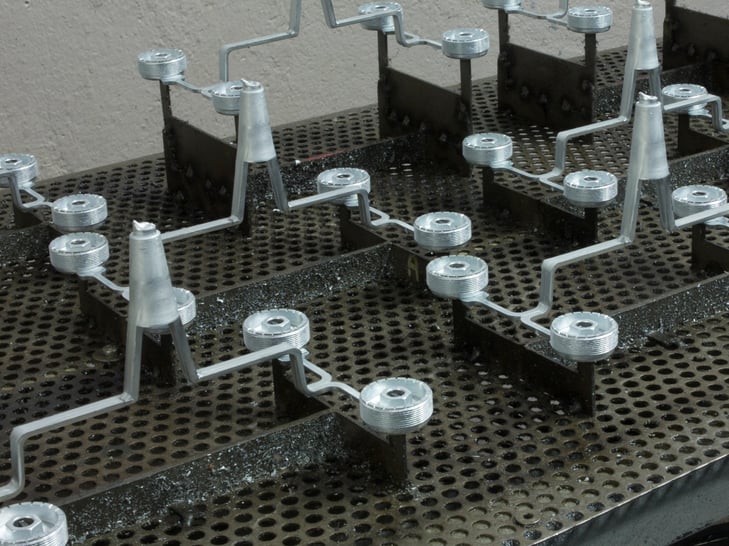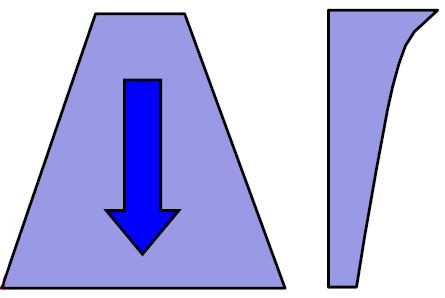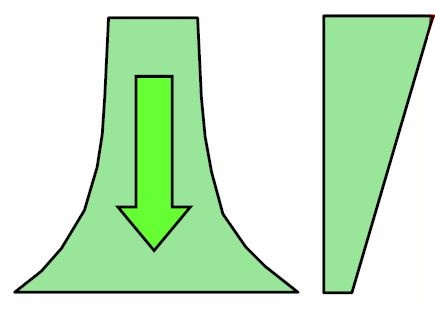As winner of numerous international awards, Bruschi Spa is known for its innovative approach in design and technology. We are glad to share our insights and experiences with the industry members.
Casting process optimization: design of hot chamber injection system
In this post we are going to describe the designing process of a hot chamber injection system, useful for casting process optimization.

The connection between the injection system and the shot entry is composed of two main elements: the feed and the runner. Their structure and size have a crucial impact on the casting flow, since different shape can bring about different results and help in reducing the risk of defects in the die casted product.
Runner positioning
To define the ideal position of the runner it is necessary to keep in mind that molten metal should cover the shortest distance possible to avoid premature cooling. Because of this, it is usually suggested to direct the flow towards the smallest side of the cavity, or to take advantage of ribs and branches to ease cavity filling. When dealing with more than one shot entry, it is important that flows are not convergent, since that would cause an energy loss and the formation of turbulences and air trappings: therefore, it is best to design the runner to obtain parallel or divergent flows.
Runners position it is also crucial to keep under control the distribution of shrinkage porosity. It is impossible to avoid porosity, but it is possible to manage it. In fact, in order to obtain a disperse and uniform porosity the shot entry should be placed in correspondence to the thinner parts of the casting, while in order to obtain a reduction of the porosity in a massive zone the shot should be placed next to the thicker parts of the casting.
Moreover, the flow should be directed towards those zone with high quality requirements: to obtain a high surface quality it is needed that the cast should be as direct as possible. These precautions lead to a better control of shrinkage porosity and thus to a casting process optimization.
Design and dimension of runners
Another important element to consider is the shape of the runners. Normally the most used shape is trapezium, but for some high tolerance alloys, such as Zamak, runners with circular cross-sections can be used: this reduces energy dissipation, thus preserving flow’s temperature.
During the designing phase, the ratio between the runner’s section and the shot entry should be kept in mind, but there is no universal rule: the choice depends on the wanted result. Smaller runners allow for a saving of both material and energy, but require more power from the injection system and are more subjected to premature solidification. On the other hand, larger runners require more material and energy, but have higher hydraulic efficiency and increase the thermic value of the mold. Therefore, they require also a longer cooling time which could have a negative impact on the cycle time.
Moreover, the cross-section of the runner should be decreasing in size through their whole length, and this applies also to branches: the entering section should be equal or larger than the exiting one. If the main branch splits to two runners with the same cross-section, the resulting runners should also be of the same size, and their sum should be equal or smaller than the main branch.
Another issue regarding the design of the runner could be the presence of sharp edges and the discontinuity of flow deviations, the most critical points in the design of the runners. They should be avoided to prevent the formation of turbulences. When working with compound dies a particular attention should be given to construction and assembly errors, because the formation of bottlenecks and bulges could damage the metal flow. This kind of mistakes can be fixed in the tool shop, allowing for a recovery of the original functionality of the mold.
Finally, it is important that the volume of the runners will let the metal flow in the cavities at the same time, and that is why their length must be constant.
To allow the casting to be evenly distributed in all the cavities, it is necessary to attach the main runner to the injector with a feed.
The feed
The feed is a junction needed to pass from the squared section of the injection channel to the thin one of the shot entry. There are many different types of feeds and each one has different advantages, but all have the same main functions: to make the passage between the channel and the entry more gradual, so as to contrast metal tendency to withdraw from walls, and to direct metal flow.
The most common models of feed are the fan feed and the double tangent feed:
- The fan feed creates a narrow flow with a higher speed in the middle. Because of this, it is more suitable for short and thick shot entries, and it is ideal for small angles;
- The double tangent feed produces a larger flow, with higher speed at the sides. Because of this, it is more fitting for long and thin shot entries and offers larger angles;
Independently form the chosen type of feed, the section should be linearly decreasing from the channel to the shot entry. This means that it is not enough to use a trapezium-based feed, but it will be necessary to curve either the base surface or the side’s surface.
Pro and Cons of a straight feed

The term “Straight feed” identifies those feeds with a straight trapezium base and curved sides. The main advantage of this kind of feed is that the opening angle is the same as the half-opening of the feed, making it easier to remove the runners, while the main disadvantage is the tendency to work with a cold shot entry. Moreover, the flow generated by this feed has a narrower leading front and thus the metal has a tendency to withdraw from the walls.
Pro and Cons of a curved feed

The curved feed is a feed characterized by straight sides and a curved base. It is ideal when it is necessary to have a stronger flow to the sides, but the opening angle is harder to calculate and it causes the formation of small parts that require removal. The flow created by this kind of feed has an higher speed in the middle and metal tends to stick to the walls.
After learning about their strengths and weaknesses, it should be clear that, just like the runners, the type of feed should be chosen depending on the wanted result, on the power of the injection machines and on other secondary conditions. By allowing a better control of the casting flow and reducing the risk of air trapping formations, the feed is a fundamental tool for casting process optimization.
To learn more about mold design and other techniques for die casting, subscribe to our blog.

